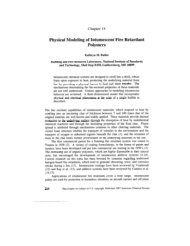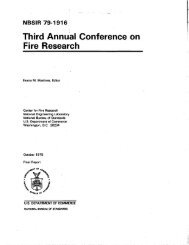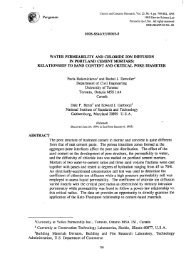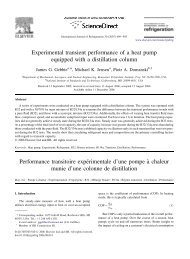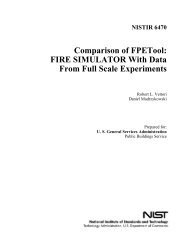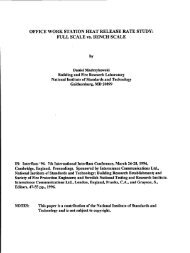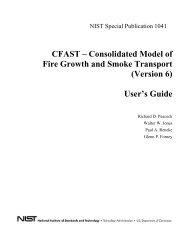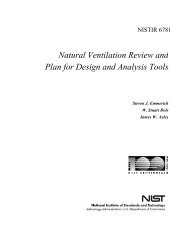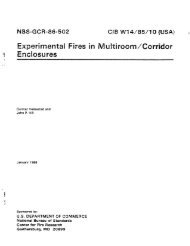Study of Technology for Detecting Pre-Ignition Conditions of ... - NIST
Study of Technology for Detecting Pre-Ignition Conditions of ... - NIST
Study of Technology for Detecting Pre-Ignition Conditions of ... - NIST
Create successful ePaper yourself
Turn your PDF publications into a flip-book with our unique Google optimized e-Paper software.
QSC-MG95-1145<br />
which is sometimes preheated <strong>for</strong> the intiodutiion <strong>of</strong> a vegetable, but cook~ng a meat which<br />
creates its own grease is more common. Like vegetable oils, greases vaporize easily and may<br />
cause intense fires. The mass was chosen as a raonable mount to be-cooked in a 26 cm (10.3<br />
in) pan. This scenario would be especially appropriate <strong>for</strong> a cook who was in a bun-y and<br />
there<strong>for</strong>e heated EN the bacon at once on a high heat setting.<br />
Table sugar was chosen as the third food as an example <strong>of</strong> a carbohydrate. Sugar contains<br />
almost no water or ask and its low melting point allows faster vaporization than unprocessed<br />
vegetable matter. The rationale behind this selection included verbal evidence from several<br />
people who had expetiencd prob~ems with sugar ignition. The preliminary experiment with<br />
baked beans and other tests pefiomed at CPSC labs with pasta and potatoes all indicated<br />
difilcul~ or unlikelihood <strong>of</strong> igniting more wmmonly cooked cmbohydrates.<br />
The testing schedule was developed to stiemline the test set-up and to lessen the<br />
possibility <strong>of</strong> systematic errors (thou@ randomness) surfacing in the results. The test matrix is<br />
presented in Table 3. A total <strong>of</strong> men~-~o tests were conducted, <strong>of</strong> which only two used the<br />
smoothtop range. Six <strong>of</strong> the tests were repeated to detemine consistency <strong>of</strong> results. The<br />
selection <strong>of</strong> tests to be repeated was random because all <strong>of</strong> the tests exhibited similar smoking<br />
and ignition phenomena. A general overview <strong>of</strong> the ignition behavior <strong>of</strong> the various scenarios<br />
was desired which would lead to more rigorous testing <strong>of</strong> a specific signature or signatures in<br />
Phase II under a variety <strong>of</strong> conditions to determine widespread applicability and reliability.<br />
2.2 I~sme~tatio~<br />
A variety <strong>of</strong> instruments was implemented to attempt to characterize the pre-i~ition<br />
cooking environment. Memuremen= focused on themal aspects <strong>of</strong> the area with an attempt to<br />
gain chemical, plume smoke, and plume velocity in<strong>for</strong>mation as well. The goal <strong>of</strong> the ef<strong>for</strong>t was<br />
to ascertain which mewuremen@ are effective <strong>for</strong> indicating approaching ignition conditions<br />
without regard to practicality which will be a subject <strong>of</strong> fvture studies. Figure 2 is a pictorial<br />
diagram <strong>of</strong> the layout <strong>of</strong> the instmmen~ <strong>for</strong> these tests.<br />
2.2.1 Thermocouples<br />
Thermocouples were used to measure temperatures in three general areas: the plume, the<br />
p- and the range. The buoymt plume above the pan which consisted <strong>of</strong> hot air, gases, and food<br />
aerosols generated by the heating process was equipped with a grid <strong>of</strong> thermocouples as shown<br />
in Figure 3. The vertical centerline, or axis <strong>of</strong> symmetry, <strong>of</strong> the pan was monitored with six<br />
thermocouples, and three heights were h~rizontally mapped with three additional thermocouples<br />
each. The themomuples were Omega model no. 5TC-GG-(K)-30-(72) [30 gauge, 0.25 mm<br />
(0.010 in) diameter, K-type (Chromel-Alumel), 183 cm (72 in) long, glass braid insulation].<br />
*Certain commercial equipment, instruments, or materials are identified in this report to<br />
specify adequately the expetimentil procdure. Such identification does not imply<br />
recommendation or endorsement by the National Institute <strong>of</strong> Standards and <strong>Technology</strong>, nor does<br />
it imply that the materials or equipment identified are necessarily the best available <strong>for</strong> the<br />
purpose.<br />
8



